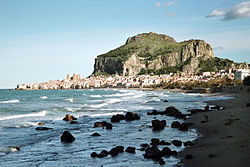Cefalù
| Cefalù, Italy | ||
|---|---|---|
| Comune | ||
| Comune di Cefalù | ||
 |
||
|
||
| Location of Cefalù, Italy in Italy | ||
| Coordinates: 38°02′N 14°01′E / 38.033°N 14.017°ECoordinates: 38°02′N 14°01′E / 38.033°N 14.017°E | ||
| Country | Italy | |
| Region | Sicily | |
| Province / Metropolitan city | Palermo (PA) | |
| Frazioni | Sant'Ambrogio, Gibilmanna | |
| Government | ||
| • Mayor | Rosario Lapunzina (PD) | |
| Area | ||
| • Total | 65 km2 (25 sq mi) | |
| Elevation | 16 m (52 ft) | |
| Population (2007) | ||
| • Total | 13,777 | |
| • Density | 210/km2 (550/sq mi) | |
| Demonym(s) | Cefaludesi or Cefalutani | |
| Time zone | CET (UTC+1) | |
| • Summer (DST) | CEST (UTC+2) | |
| Postal code | 90015 | |
| Dialing code | 0921 | |
| Patron saint | Madonna dell'Immacolata | |
| Saint day | December 8 | |
| Website | Official website | |
Cefalù (Italian pronunciation: [tʃefaˈlu]; Sicilian: Cifalù; Greek: Κεφαλοίδιον Kephaloídion, Diod., Strabo, or Κεφαλοιδίς Kephaloidís, Ptol.; Latin: Cephaloedium, or Cephaloedis, Pliny) is a city and comune in the Province of Palermo, located on the northern coast of Sicily, Italy on the Tyrrhenian Sea about 70 kilometres (43 mi) east of the provincial capital and 185 kilometres (115 mi) west of Messina. The town, with its population of just under 14,000, is one of the major tourist attractions in the region. Despite its size, every year it attracts millions of tourists from all parts of Sicily and also, from all over Italy and Europe.
Of Greek foundation, the city evidently derived its name from its situation on a lofty and precipitous rock, forming a bold headland (Κεφαλή) projecting into the sea. Despite the Greek origin of its name, no mention of it is found in the works of Thucydides, who expressly says that Himera was the only Greek colony on this coast of the island; it is probable that Cephaloedium was at this time merely a fortress (φρούριον) belonging to the Himeraeans, and may very likely have been first peopled by refugees after the destruction of Himera. Its name first appears in history at the time of the Carthaginian expedition under Himilco, 396 BC, when that general concluded a treaty with the Himeraeans and the inhabitants of Cephaloedium. But after the defeat of the Carthaginian armament, Dionysius the Elder made himself master of Cephaloedium, which was betrayed into his hands. (Ibid. 78.) At a later period we find it again independent, but apparently on friendly terms with the Carthaginians, on which account it was attacked and taken by Agathocles, 307 BC. In the First Punic War it was reduced by the Roman fleet under Atilius Calatinus and Scipio Nasica, 254 BC, but by treachery and not by force of arms.Cicero speaks of it as apparently a flourishing town, enjoying full municipal privileges; it was, in his time, one of the civitates decumanae which paid the tithes of their corn in kind to the Roman state, and suffered severely from the oppressions and exactions of Verres. It also minted coins. No subsequent mention of it is found in history, but it is noticed by the geographers Strabo, Pliny, and Ptolemy, among the towns of Sicily, and at a later period its name is still found in the Itineraries.
...
Wikipedia


